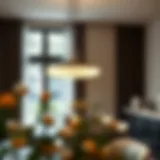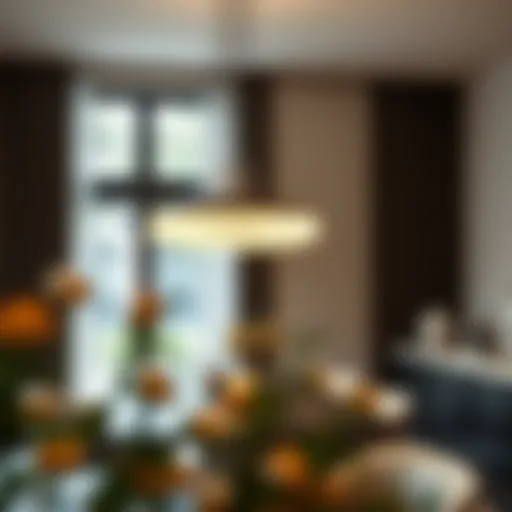Guide to Library Bookshelves: Styles and Purchase Tips
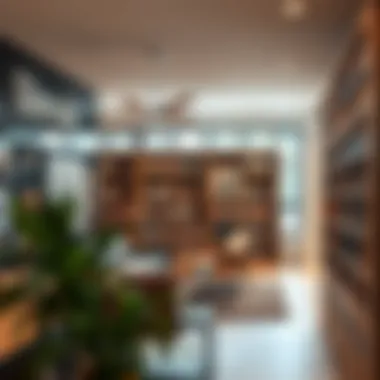

Intro
When one thinks about a library, the image that often pops to mind is that of towering shelves loaded with books, organized and waiting to be perused. While the literary contents are undeniably important, the shelves that house these manifestations of knowledge often do not receive as much consideration. Selecting the right bookshelves can transform a space, making it either a charming nook for personal enjoyment or a sophisticated area for professional use. Understanding the various styles, materials, and functionalities available is crucial for anyone looking to curate their own library, either at home or in a public setting.
This comprehensive guide aims to shed light on the essential aspects of library bookshelves on the market today. From classic wooden designs to modern minimalist options, there are an array of choices to ponder over.
Furniture Design Styles
When it comes to bookshelves, design style plays a significant role. Your choice of bookshelf can resonate with your personal aesthetic, while also complementing the style of the rest of your home or office.
Overview of Popular Styles
There are various styles available, each presenting its own distinct character:
- Traditional: Often constructed from hardwood, traditional bookshelves exude a timeless charm. They may include intricate carvings and rich finishes, making them a centerpiece in any classic library.
- Modern/Minimalist: If sleek lines and simplicity appeal to you, modern bookshelves are the way to go. They often utilize materials like metal and glass, merging elegance with practicality.
- Industrial: Combining rustic charm and robust construction, industrial bookshelves made from reclaimed wood and steel lend a unique, urban touch to any space.
- Contemporary: This style embraces innovation with avant-garde designs that can be both functional and decorative. Think unusual shapes and creative layouts in your picks.
How to Mix and Match Styles
There’s no rule saying you have to stick to one design style. Mixing and matching can create a delightful aesthetic:
- Choose a Focal Point: Start with a standout piece, like a bold industrial shelf, and build around it with complementary styles.
- Use Color as a Unifier: Picking items with a common color scheme can tie diverse styles together seamlessly.
- Balance Proportions: When combining different designs, ensure that they maintain visual equilibrium. Pairing an ornate traditional shelf with a sleek contemporary piece can create a striking contrast.
Practical Tips for Homeowners
As you embark on your journey to find the ideal bookshelf, there are some practical considerations to keep in mind.
Essential Buying Tips
- Measure Your Space: Before making any decisions, accurately measure the area where you intend to place your bookshelf. This will help you avoid unfortunate surprises and ensure that your choice fits well.
- Consider Weight Capacity: If you plan to load your bookshelf with not just books, but decorative items and personal treasures, ensure it can handle the weight.
- Materials Matter: Each material has its pros and cons. Wood is classic and sturdy, while metal offers longevity and versatility. Determine what works best for your needs.
Maintenance and Care Guidelines
Maintaining your bookshelf is essential for longevity:
- Dust Regularly: Use a soft cloth to regularly dust shelves to keep them looking fresh and new.
- Avoid Direct Sunlight: Positioning bookshelves in direct sunlight can fade the wood and damage the books, so think carefully about placement.
- Check for Stability: Periodically assess the stability of your shelves for safety's sake, especially if you are working with taller units.
"The bookshelves we choose tell an intricate story about who we are and the worlds we wish to explore."
For more insights into library organization and design ideas, consider exploring resources like Wikipedia or Britannica.
Understanding the Importance of Library Bookshelves
When it comes to crafting a space that reflects both functionality and personal style, library bookshelves serve a crucial role. They are not merely storage solutions; they contribute significantly to the overall aesthetic and functionality of a room. The choices one makes in selecting the right bookshelves can influence the ambiance of the library or reading nook, making it feel more inviting and organized. A well-chosen bookshelf can be a conversation starter, merging utility and art in a seamless connection.
The Role of Bookshelves in Interior Design
Bookshelves can be seen as the backbone of interior design in any space dedicated to reading or reflects a love for literature. They have a distinct capability to dominate a wall or fit snugly into a corner while adding character and depth to the atmosphere. In a modern context, these shelves can also act as the backdrop for various decorative elements—think family photographs, art pieces, or even potted plants that enhance the environment.
Colors, materials, and styles of bookshelves react with other design aspects in the room; for instance, a rustic wooden bookshelf can add warmth and coziness, whereas a sleek metal design embodies contemporary chic. The right bookshelf creates zones within a larger space, allowing for fluid transitions from reading, working, or simply relaxing. Together with other furniture pieces, the design of the bookshelves can lead to a harmonious balance, guiding the viewer's eye and elevating the space.
Practical Benefits of Bookshelves
Selecting the appropriate bookshelf comes with practical and aesthetic benefits. First off, shelves provide organization, helping to mitigate the chaos that can arise from an excess of books, magazines, or decorative artifacts. An organized bookshelf not only makes it easier to find what you're looking for, it also contributes to a sense of calm.
In addition, these shelves can store more than just books. They can house games, collectibles, and any items you hold dear, maximizing utility without cluttering the space. Here are a few advantages of installing bookshelves:
- Maximized vertical space: Tall bookshelves can utilize height, providing ample storage while keeping the floor clear for other uses.
- Customized designs: With options ranging from modular designs to custom-built solutions, bookshelves can be tailored to meet specific needs and style preferences.
- Multi-functionality: Many contemporary designs integrate lighting or seating capabilities, transitioning the bookshelf from a simple storage unit to a multi-use piece.
"Bookshelves are not just mere holders of books; they are integral to the identity of a space, asserting presence through design and functionality."
Types of Library Bookshelves Available for Sale
When one begins the journey to find the perfect library bookshelf, it becomes clear that the variety available is nothing short of remarkable. As homeowners, interior designers, and furniture enthusiasts peruse the market, they are often met with an array of styles, each with its own unique charm and benefits. Understanding the types of bookshelves available is essential, as this knowledge helps guide thoughtful decisions that blend functionality with aesthetic appeal. Whether one is after a classic wooden structure or a sleek modern piece, there is a bookshelf designed to meet specific needs.
Traditional Styles
Traditional bookshelves evoke a sense of nostalgia. These are the shelves that remind us of local libraries and cozy reading nooks. Typically made from rich woods like oak or mahogany, they often feature ornate details and intricate mouldings. This style caters to those who appreciate timeless elegance and craftsmanship.
For instance, a solid wood bookshelf with hand-carved accents can be the crowning jewel of a study, resonating with classic literature and history. What’s more, these bookshelves often incorporate adjustable shelves, providing versatility for varied book sizes. In essence, traditional styles serve not just as utilitarian furniture but also as a statement piece, inviting warmth and character into any room.
Modern Designs
On the flip side, modern designs have captured the hearts of minimalist enthusiasts everywhere. Characterized by clean lines, neutral colors, and functional simplicity, these bookshelves are intended to enhance a contemporary living space without overwhelming it. Common materials include layered plywood or sleek steel, delivering robustness with an uncluttered look.
An example can be seen in floating bookshelves, which provide an illusion of books suspended in mid-air. This type of design not only saves floor space but also provides a striking contrast against wall colors. Often, modern bookshelves include innovative features – think integrated lighting or modular configurations – which can easily transform a simple storage unit into a focal point of artistry.
Industrial Options
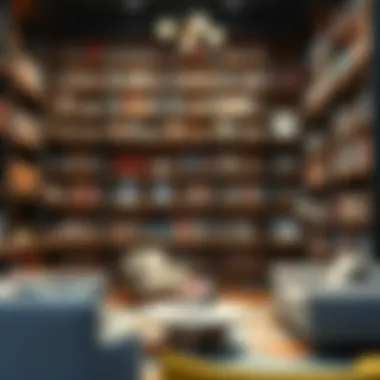

If one leans towards a more rustic or urban aesthetic, industrial bookshelves become a prime consideration. These pieces often blend reclaimed woods with metal elements, creating a raw and edgy vibe that speaks to an era of repurposed materials. The robustness of these bookshelves is matched by their design, which often exposes the structural components, offering a sense of authenticity.
Consider a bookshelf crafted from weathered timber, supported by pipe-style brackets. This not only serves as a storage solution but also pays homage to industrial craftsmanship. As such, they fit beautifully in loft-style apartments or spaces aiming for a modern yet rugged appeal.
Customized Solutions
Lastly, some individuals may seek more tailored options that precisely match their vision. Customized solutions allow for the meticulous adjustment of dimensions, design features, and materials based on specific tastes and spatial requirements.
Whether one prefers a sectional bookshelf to fit snugly in an awkward corner or a brightly-painted shelf to serve as a vibrant accent, custom builds cater to varied needs. Engaging with local craftsmen or using online platforms that specialize in bespoke furniture opens the door to endless possibilities. Not only does this approach ensure that the shelf aligns with one's personal style, but it also means that the bookshelf can be designed to accommodate unique collections or specific décor themes.
In summary, the types of library bookshelves available for sale reflect a wide spectrum of choices. From the storied charm of traditional styles to the sleek functionality of modern designs, each type offers something valuable. By recognizing the differences as well as the opportunities to customize, individuals can find that perfect bookshelf which not only meets practical needs but also elevates their living environment.
Materials Used in Library Bookshelves
Understanding the materials that go into library bookshelves is fundamental for anyone looking to buy furniture that works well in a variety of settings. The choice of materials not only affects the durability and functionality but also the overall aesthetic appeal of the shelving unit. Various materials, such as wood, metal, and glass, offer distinct characteristics and benefits. Knowing these can lead to informed decisions that ensure your selected bookshelf enhances both the look and utility of your space.
Wood
Using wood for bookshelves stands out due to its natural warmth and versatility. It's a classic material often associated with quality craftsmanship, lending an air of sophistication to any room.
Types of Wood
When talking about types of wood, each variety brings its own set of benefits to the table. Hardwoods, like oak and cherry, are celebrated for their robustness. Oak, for instance, can withstand the test of time, making it a popular choice for library bookshelves. On the other hand, softer woods like pine are lighter and can be easier to manage when designing a room on a budget.
A unique feature of hardwood is its grain pattern. This intrinsic characteristic allows for both aesthetic and functional benefits. For example, the natural variations in grain make each bookshelf a one-of-a-kind piece. However, hardwood can come with a heftier price tag compared to softer options.
Finishes and Treatments
Finishes and treatments add another critical layer when assessing wooden bookshelves. Stains, varnishes, and sealants can significantly impact both appearance and durability. A glossy finish can help repel dust and moisture, which benefits long-lasting usability. Moreover, treated wood often becomes more resistant to scratches and dents.
A key characteristic of finishes is their ability to enhance the natural beauty of wood without hiding its unique grain. For instance, a matte finish may give a rustic feel, while a high-gloss option can make the wood pop, showcasing its inherent beauty. However, it's important to note that some treatments can emit strong chemicals, so consider low-VOC options for a healthier indoor environment.
Metal
Metal is increasingly favored in bookshelf design due to its strength and modern aesthetic. Weather you prefer a futuristic look or a rugged industrial vibe, metal can be molded into various designs, making it quite adaptable.
Sustainability Considerations
Talking about sustainability, metals like steel can often be recycled, contributing to environmentally-friendly designs. This resonates with a growing audience aiming to make more responsible furniture choices. Using recycled materials can significantly reduce the carbon footprint associated with manufacturing new goods.
One unique feature of metal is its longevity. A metal bookshelf can often outlast wooden alternatives, giving it a surprising edge in terms of value. Yet, the heavy weight can sometimes limit placement options in your home or office.
Design Impacts
When diving into design impacts, metal bookshelves can offer a sleek, modern look that can amplify the elegance of a room. For example, an open metal frame paired with wooden shelves imparts both warmth and sophistication. A major benefit of this combination is accommodating varied styles, from minimalist to steampunk. However, some may find metal less inviting than wood, which could affect the overall atmosphere of a space.
Glass
The use of glass in bookshelves can produce a striking visual effect, allowing light to play through the shelves and making the space feel larger. It can also provide a stunning backdrop for showcasing collectibles and books alike.
Functional Aspects
From a functional standpoint, glass shelves can create a feeling of openness. They are also easy to clean, which works well in high-traffic areas that attract dust and fingerprints. However, one must be cautious; glass can be quite heavy and often requires robust support. Hence, sturdiness is a pivotal point to consider.
Another noteworthy characteristic is transparency. This feature permits a seamless blending of the bookshelf with any existing decor, making it a versatile choice.
Aesthetic Contributions
When exploring aesthetic contributions, glass has a clean, modern touch that can elevate ordinary interior designs into something extraordinary. Utilizing glass shelves allows for seeing through while also showcasing the contents beautifully.
One downside is that glass can sometimes lack warmth compared to wood, making a room feel a bit cold, especially if overused. Striking a balance between glass and other materials can hence be paramount.
Overall, understanding the types, finishes, and materials used in library bookshelves can make a significant difference in achieving the desired aesthetic and functionality. Proper selection will not only satisfy immediate needs but also provide longevity and appeal to your library setting.
Key Features to Consider When Buying Bookshelves
When embarking on the journey to select the perfect bookshelf, it is essential to gauge multiple factors that play a pivotal role beyond mere aesthetics. The right bookshelf can profoundly affect both the functionality and the visual appeal of the space. Thus, evaluating features like size, weight capacity, adjustability, and style becomes paramount. These elements not only ensure that the shelf fits your specific needs but also enhance how harmoniously the bookshelf integrates with existing decor.
Size and Space Considerations
Deciding on the size of the bookshelf is no trivial endeavor. Consider the measurements of your room, the height of your ceiling, and even the available wall space. A bookshelf that seems perfect in dimensions can turn into an eyesore if it overhangs or consumes an entire wall, overshadowing other furnishings. If you're short on space, maybe a vertical shelf or corner bookshelf would be the way to go. On the other hand, if you've got ample room, a long, low shelf could serve as a striking centerpiece.
- Measure Properly: Use a measuring tape and jot down dimensions before you shop. This will help you visualize better.
- Consider the Purpose: Will it hold textbooks, decor items, or both? This affects the panel length and depth needed.
Weight Capacity
The weight capacity is a feature that must not be neglected. If you’re planning to load up on heavy novels or substantial decor, then the capacity of the shelves becomes crucial. Bookshelves come with various weight supports depending on material and construction.
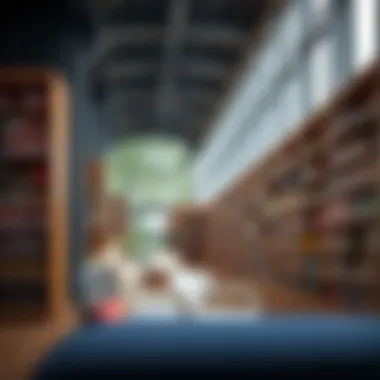

- Solid Wood vs. Particle Board: Solid wood usually boasts a higher weight capacity. In contrast, particle board may struggle under heavy loads.
- Read Specifications: Always check the manufacturer’s weight guidelines to avoid accidents that could damage the shelf or your belongings.
Shelf Adjustability
For many users, the ability to adjust the height of shelves is increasingly becoming a non-negotiable. A bookshelf with static shelves can be limiting. Being able to customize the shelves allows flexibility depending on what you're storing. You might find that children's books or flowering plants have different height requirements over time.
- Modular Systems: These can be adapted as wants and needs change, making them more useful in the long run.
- Ease of Adjustment: Pay attention to whether the shelves require tools for rearranging, as some might be cumbersome to modify.
Style Coordination with Existing Furniture
Finally, a bookshelf should complete your ensemble rather than clash with it. Ask yourself how its design meshes with your current interiors. This could involve matching wood tones, colors, or styles. Is your decor minimalist or eclectic? An ill-fitting shelf can disrupt the overall harmony of your space.
- Materials and Finishes: A sleek glass shelf might suit a modern room, while a rustic wood variant could fit better in a traditional setting.
- Color Palette: Neutral shades usually allow for more interchangeability, while bold colors may require a meticulous match with surrounding elements.
"The right bookshelf is not just about storing books; it’s a statement piece that can dramatically shape the room’s atmosphere."
Shopping for Library Bookshelves: Where to Find Them
Finding the right library bookshelves is not just about browsing through a catalog or visiting the nearby store. It’s a quest that blends aesthetics with utility—a journey, if you will. The importance of knowing where to look cannot be overstated. Whether it’s for a cozy home library or a more professional setup, the right shelves can make or break the space.
When shopping for library bookshelves, consider factors such as the style, material, and not least, the budget. But where do you begin this search? Let's break down some of the most effective avenues.
Online Retailers
In today’s digital age, online retailers have made shopping for library bookshelves easier than ever. Websites, such as Amazon and Wayfair, showcase a bewildering variety of styles and price ranges. You can scour through hundreds of options from the comfort of your couch, and often, you'll find exclusive online discounts that can lighten your financial load.
"The vast sea of online choices might feel overwhelming, but each website often has filters to help narrow down results according to size, style, and material."
Shopping online also means you can read customer reviews before making a decision. These honesty-filled stories can give insightful perspectives on the durability and aesthetic appeal of specific options. However, don’t forget to check the shipping costs and return policies; they can sneak up on you and affect your final budget.
Local Furniture Stores
There’s something about walking into a local furniture store that can’t be replicated online. It’s the chance to see, touch, and sometimes even test the furniture before making a purchase. Local stores like IKEA or your neighborhood mom-and-pop shops can offer unique selections that online retailers might not, particularly when it comes to handcrafted or vintage pieces.
Shopping locally supports your community as well, establishing a relationship with small business owners who often have a wealth of knowledge about their products. You can ask questions, negotiate prices, and sometimes even find custom solutions that cater exactly to your needs. Just remember, inventory can vary, so a particular design might not always be available at each visit.
Second-Hand Marketplaces
Don’t overlook the potential gold mine that is the second-hand market. Platforms such as Craigslist or Facebook Marketplace often list gently used bookshelves that are not only budget-friendly but add unique character to your space. You might stumble across a vintage find that speaks to your style and is kinder to your wallet.
While buying second-hand bookshelves, be sure to inspect them carefully. Look for signs of wear or damage—like scratches, dents, or unstable joints. The beauty of this option is that you often get hard-to-find items at a fraction of the cost, allowing for more creative freedom in your design.
In summary, the world of bookshelves is vast and varied. Choosing where to shop isn’t just about price; it’s also about the experience, aesthetic, and functionality. Whether opting for online convenience, local treasures, or second-hand gems, your ideal bookshelf is surely out there waiting for you.
Budgeting for Library Bookshelves
When embarking on the journey of selecting library bookshelves, budgeting stands as a cornerstone of the entire process. Understanding your financial boundaries not only sets the stage for what is feasible, but it also influences every decision made thereafter. A precise budget will guide you in navigating the vast array of options without getting lost in the myriad of choices that can lead to decision fatigue.
Key Considerations in Budgeting:
- Establish a clear financial limit based on your overall home improvement budget.
- Account for any additional costs such as delivery, installation, or customization that may not be included in the shelf's price.
- Factor in maintenance costs to keep your bookshelves in prime condition.
Having a practical budget helps you to avoid the temptation of overspending on products that don't necessarily add value or enhance your library experience. Instead, it allows for thoughtful selection among different styles and materials that complement your vision.
Understanding Price Ranges
Price ranges for library bookshelves can be as diverse as the styles they reflect. Depending on materials, design intricacy, and brand reputation, you might find varied prices, leaving many to wonder where to start. A deeper dive into these variations can provide clarity.
- Budget-friendly Options: Many standard models start around $100 to $300. These often utilize particle board or basic wood finishes, suitable for those who need functionality without frills.
- Mid-range Selections: Expect to spend approximately $400 to $800 for higher-quality wood or metal options that boast durability along with a unique flair.
- Premium Choice: For bespoke or artisanal designs, expect to see prices soar above $800, sometimes reaching thousands. This range is where you’ll find solid hardwood with exquisite craftsmanship, often integrating intricate designs or eco-friendly materials.
"Understanding the market value of what you are purchasing ensures that you spend wisely and gain quality for your money."
When planning your budget, be sure to also explore second-hand options or local craftsmen who may offer more competitive pricing, which could be beneficial in stretching your dollar further.
Investments vs. Savings
The conversation about budgeting doesn’t just revolve around finding low prices; it also touches on the concept of -investments vs. savings. This distinction plays a critical role in how you approach your bookshelf purchase.
Investments are bookshelves that promise longevity and aesthetic pleasure, often reflecting personal taste and enhancing your property’s value. These selections typically involve a higher upfront cost but may save you money in the long run due to their durability. High-quality materials like solid wood or premium metals can withstand wear better than cheaper alternatives.
Conversely, savings* come into play when looking at short-term costs rather than quality. While it’s tempting to go for the cheaper option, consider the implications: you might end up replacing a low-cost shelf multiple times, which could ultimately mean more spending than a one-time investment in a high-quality piece.
When you blend careful budgeting with a mindsight of investment versus savings, you position yourself to make choices that will not only satisfy your immediate needs but also serve well in the long haul.
Maintenance and Care for Library Bookshelves
Maintaining and caring for library bookshelves is often overlooked, yet it's critical for preserving their integrity and appearance. Library bookshelves serve not only as a means to store books but also as an aesthetic statement within a room. Proper upkeep prolongs their lifespan and ensures they remain a valuable addition to your interior. Moreover, well-maintained bookshelves enhance the overall atmosphere of your space, enabling an inviting and scholarly environment.
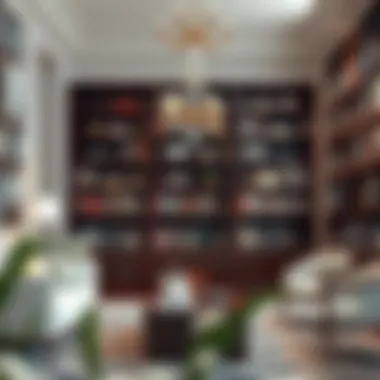

Cleaning and Dusting Techniques
To keep your library bookshelves looking sharp and polished, routine cleaning is essential. Here's how you can do it effectively:
- Routine Dusting: Use microfiber cloths to dust the shelves regularly. Unlike traditional cloths, microfiber captures dust rather than spreading it around. Simply run the cloth along the shelves and around the books. This technique is particularly effective if you're maintaining a collection of older or rare books, as dust can be detrimental to their condition.
- Vacuum Delicately: For those shelves that have accumulated significant dust deposits, vacuuming using a brush attachment can be handy. Ensure the vacuum is on a low setting to avoid scratching the wood or damaging any delicate materials.
- Spot Cleaning: If you spot stains or marks, use a very mild soap solution. Dampen your cloth—not soak it—and gently wipe the affected area. Test your cleaning solution on an inconspicuous area first to avoid impacting the finish.
With these techniques, you can reduce dust accumulation efficiently while also avoiding damage to the surface of the bookshelves.
Repairing Minor Damages
Even the sturdiest bookshelves can sometimes suffer minor damage, whether it's scratches, dents, or loose joints. Addressing these issues promptly can save you from more extensive repairs down the line. Here's a breakdown of how to tackle common problems:
- Scratches and Scuff Marks: Use matching wood fillers or a simple walnut if the shelves are wooden. Rubbing the nut over the scratch can mask the blemish effectively. For deeper scratches, applying wood stain can blend the sanded area with the rest of the shelf.
- Tightening Loose Joints: If you notice a bookshelf that's become wobbly, check for screws or bolts that may need tightening. A screwdriver or wrench works for most cases. If a more extensive problem arises, consider using wood glue for joint repairs, ensuring a stable and secure structure.
- Replacing Shelf Supports: If your shelves feel uneven, check the support pins or brackets. They may be bent or broken, causing instability. Simply replace them to restore the strength of your shelving.
Taking a proactive stance on minor repairs not only preserves the visual appeal of your bookshelves but also secures the safety of the items stored within them.
"Regular maintenance of bookshelves isn't just about aesthetics; it's a commitment to preserving knowledge and culture housed within them."
Caring for your library bookshelves can feel like a daunting task, but with a bit of diligence and knowledge, the process becomes significantly more manageable. By understanding appropriate cleaning techniques and methods to repair minor damages, you boost the utility and lifespan of your bookshelves, ensuring they remain as a central feature in your home for years to come.
Trends in Library Bookshelf Designs
In today’s fast-paced world, library bookshelves are evolving beyond mere storage units. They’ve become essential elements in interior design, influencing both aesthetics and functionality. When we talk about trends in library bookshelf designs, we’re discussing shifts that reflect the changing tastes and needs of society. From sustainability to aesthetics that complement multifaceted living spaces, these trends serve various purposes while also making a statement.
Sustainable Materials
Sustainability is not just a buzzword; it’s a necessity in modern design practices. As eco-consciousness grows among consumers, the demand for bookshelves made from sustainable materials is on the rise. This includes wood sourced from responsibly managed forests, bamboo, and recycled materials.
- Environmental Impact: Choosing sustainable materials can significantly reduce one’s carbon footprint. Opting for reclaimed wood not only gives an item a unique character but also contributes to environmental conservation.
- Durability and Longevity: Many sustainable materials, like high-quality plywood or bamboo, offer excellent durability, ensuring that the shelf can support a collection of books for years without bending or breaking.
- Aesthetic Appeal: Sustainable materials often come in unique finishes and textures. A raw, natural wood finish or a sleek painted bamboo shelf can add warmth or modernity, respectively, depending on the overall design scheme.
Exploring sustainable options opens the door for creative expression while aligning with values that many consumers now prioritize. Rather than merely occupying physical space, bookshelves can now embody principles of ecological responsibility.
Functional Aesthetics
Another prominent trend in library bookshelf designs is the concept of functional aesthetics. This principle emphasizes utility without sacrificing beauty. In a world where spaces are becoming more compact, multifunctional designs are highly prized.
- Dual-Purpose Designs: Many modern bookshelves feature integrated workspaces or seating. For example, a bookshelf can incorporate a cozy reading nook, providing both storage and a comfortable place to indulge in literature.
- Visual Extension of Space: Smart shelving can create an illusion of space. A well-placed glass shelving unit can maintain an open feel, while strategically arranged books can add depth to a small room.
- Customization: The diversity of designs now caters to personal taste while remaining functional. Homeowners can choose designs that reflect their personality, from minimalism to an eclectic mix of styles, ensuring the bookshelf complements the rest of the decor.
"Functional aesthetics bridges the gap between style and utility, showing that design doesn't have to compromise one for the other."
Keeping these trends in mind when selecting a bookshelf allows individuals to find a piece that resonates with their identity while enhancing their living or working environment. By focusing on sustainable materials and functional aesthetics, one can create a library space that is not only visually enchanting but also practical.
Innovative Solutions and Multifunctional Designs
In today’s fast-paced world where space is at a premium, the integration of innovative solutions and multifunctional designs in library bookshelves emerges as a vital consideration for anyone looking to optimize their living or work environment. These designs not only elevate the aesthetic appeal of a space but also maximize its functionality, making them an attractive option for designers, retailers, homeowners, decorators, and the DIY crowd. Multifunctionality can mean the difference between a cluttered home and a well-organized haven, which is why textbooks and design manuals have increasingly begun to applaud these contemporary approaches.
Bookshelves with Integrated Seating
One of the standout innovations in bookshelf design is the creation of bookshelves with integrated seating. The concept might seem simple, yet it serves multiple purposes by cleverly combining two essential elements of modern design: storage and relaxation. Imagine a cozy nook in your favorite reading corner, built into your bookshelf. Not only do these custom solutions provide you a spot to sit and enjoy your literary treasures, but they also save valuable floor space.
- Space Efficiency: By merging seating and shelving, these designs effectively reduce the number of furniture pieces you need, great for smaller apartments.
- Customizability: Homeowners can tailor these units to fit their specific style and space requirements, ensuring that both form and function are achieved.
- Creative Flair: You can enhance the overall look by playing around with cushions and textiles, which allows for personal expression—even within humble book stacks.
- Encouraging Reading: With a comfy seat right beside the shelves, it invites you to relax and browse through your collection.
These multifunctional shelves are ideal for anyone looking to inject practicality into their interiors without compromising on style. You can boast about a space that not only looks chic but is also designed for leisure and enjoyment.
Bookshelves with Lighting Features
Lighting is another innovative feature being integrated into bookshelf designs, revealing an entirely new layer of functionality. Imagine shelving that not only showcases your books but also highlights them with ambient light. Shelves equipped with built-in lighting transform ordinary spaces into alluring displays, making books the stars of the show.
- Enhanced Visibility: This is especially useful in dimly lit spaces or rooms without enough natural light. Being able to see your books clearly eliminates the frustration of fumbling around in the dark.
- Mood Setting: Clever lighting can establish the right atmosphere for different activities—whether it’s a lively book club gathering or a quiet, solitary read on a rainy day.
- Highlighting Decor: These bookshelves provide a platform to showcase smaller decorative items or art pieces alongside your books, amplifying the overall visual appeal and testimony to your personal tastes.
- Energy Efficiency: With the advent of LED technology, lighting options are often energy-efficient, a great selling point for eco-conscious consumers.
"A well-designed bookshelf can serve as the heart of the room, a true reflection of its owner's persona."
In the quest to beautify and order our spaces, it’s clear that innovative, multifunctional designs are paving the way forward.
Final Thoughts on Choosing Library Bookshelves
Selecting the perfect library bookshelf is more than just a matter of preference; it's about blending form and function while addressing the specific needs of your space. The right bookshelf can transform a room, serving not only as a storage solution but also as a statement piece that reflects your style. Thus, understanding the key elements that contribute to an informed choice becomes essential.
Recap of Important Considerations
To sum up the core aspects discussed throughout this guide, it's crucial to remember the following:
- Design Alignment: The bookshelf should align with your overall decor. Whether you lean towards a traditional, modern, or industrial design, coherence in style is vital.
- Material Quality: The materials not only impact durability but also sit at the intersection of aesthetics and functionality. Consider options like wood for warmth, metal for sturdiness, and glass for a lighter appearance.
- Space Utility: Measure your available space meticulously. A bookshelf should not overwhelm your room but rather complement it. This involves not just width and height but also depth, especially if you plan to house larger volumes.
- Weight Handling: Ensure that the shelves can bear the load you intend to place on them. This consideration prevents the bookshelf from buckling under pressure and assures safety over time.
- Adjustability and Versatility: Look for shelves that allow adjustments in height, giving you the freedom to change your layout as your collection grows or evolves.
These elements serve as a comprehensive checklist when you're knee-deep in the purchasing journey, ensuring that what you select is not just visually pleasing but also functional and robust.
Encouraging Thoughtful Selection
As you stand on the brink of this decision, encourage yourself to reflect on both immediate needs and long-term goals. Think about how your library space will grow. Will you accumulate more books? Will this space potentially shift in function?
- Prioritize Functionality: Perhaps your first thought is how to visually appeal to guests, yet consider how a functional selection will serve you day-to-day. What good is a stunning shelf if it can't organize your collection efficiently?
- Sustainability Matters: If your values lean towards sustainability, look into eco-friendly materials. Not only will this benefit the environment, but it can also elevate your space’s character.
- Consider Budget Over Time: It's never just about the price tag. A high-quality bookshelf can last decades, so investing in a piece that might stretch your budget slightly now may save you from future expenditures.
In essence, thoughtful selection involves merging your aesthetic desires with functional needs, ensuring the bookshelf fulfills its role in your library for years to come.




